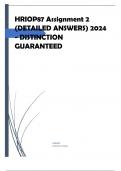HRIOP87 Assignment 2
(DETAILED ANSWERS) 2024
- DISTINCTION
GUARANTEED
ADMIN
[COMPANY NAME]
, QUESTION 1 – Nel & Kristen (2020), Chapter 2 Briefly discuss the key
ingredients of employment relations dynamics. Use the following guidelines:
1.1 Introduction Start with a critically discussing the shifting boundaries and
move beyond a strictly tripartite perspective to a multipartite perspective. 1.2
Overview of the role-players and stakeholders in employment relations.
Critically discuss the role-players and stakeholders in employment relations by
referring in your answer to employer parties, employee parties and the State.
Also, identify and explain which parties form part of the “actors”, role-players
and stakeholders in employment relations systems, with particular reference
to South Africa. 1.3 Conclusion Critically review a real-life scenario in society
(cite the reference) where you see these dynamics at play. (20)
1.1 Introduction: The boundaries of employment relations have evolved significantly,
transcending the traditional tripartite perspective involving only employers, employees, and the
state. In contemporary contexts, a multipartite perspective acknowledges the involvement of
various other stakeholders and actors, including but not limited to trade unions, professional
associations, non-governmental organizations (NGOs), international bodies, and the wider
society. This shift reflects the complex interplay of interests, power dynamics, and socio-
economic factors shaping employment relations.
1.2 Overview of Role-players and Stakeholders: In employment relations, role-players and
stakeholders encompass a diverse array of entities, each wielding influence and contributing to
the dynamics of the system.
Employer Parties: These include individual employers, business associations, and corporate
entities. They play a pivotal role in shaping employment policies, practices, and conditions
within their respective organizations. Their objectives often revolve around maximizing
productivity, profitability, and competitiveness while managing labor costs and regulatory
compliance.
Employee Parties: This category encompasses individual workers, trade unions, and worker
associations. Employees seek to advance their interests concerning wages, working conditions,
job security, and career advancement. Trade unions act as collective representatives of workers,
negotiating with employers on behalf of their members and advocating for labor rights and
protections.
The State: Government institutions and regulatory bodies play a regulatory and oversight role in
employment relations. They enact and enforce labor laws, establish minimum standards for
employment conditions, mediate labor disputes, and promote social dialogue between employers
and employees. The state's involvement aims to ensure fairness, equity, and stability in the
employment relationship, balancing the interests of employers and workers within the broader
societal context.




